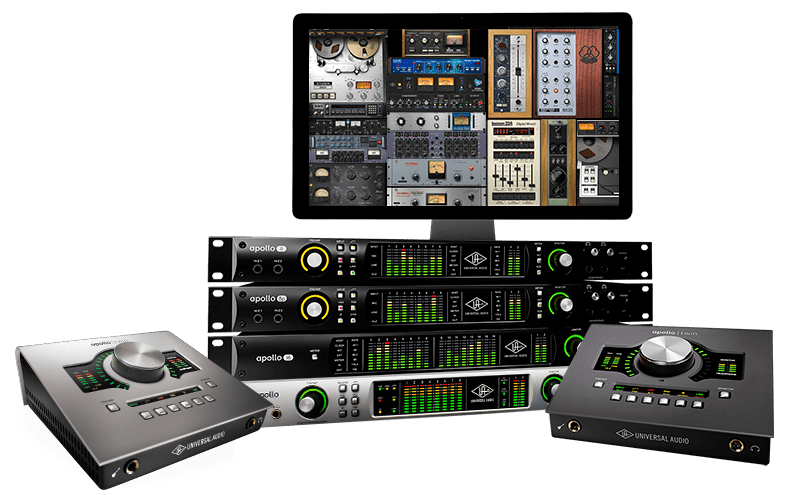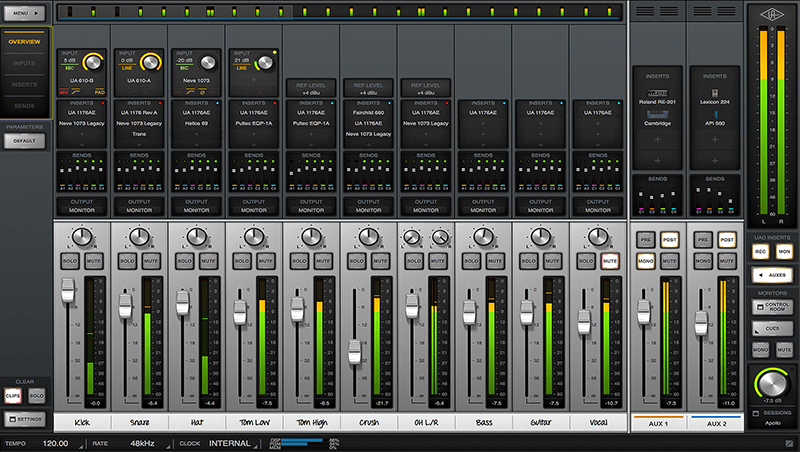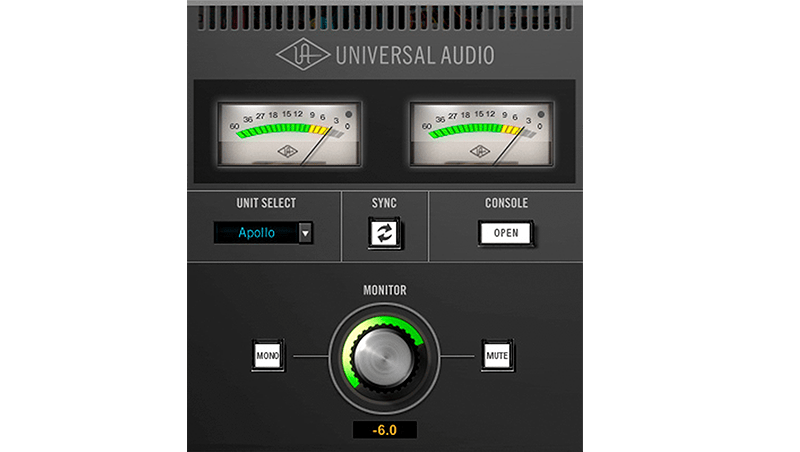
Apollo Audio Interface Basics & FAQ
What is Apollo?
Apollo is a high-resolution professional audio interface with superior sound quality and Realtime UAD Processing onboard. It features built-in UAD-2 DSP Acceleration, which allows Apollo to track, mix, and master with our full library of award-winning UAD-2 Powered Plug-Ins with nearly instant sub-2ms latency. Apollo connects to the computer via FireWire 800, and also has Thunderbolt connectivity via the Thunderbolt Option Card.
Apollo was designed to give users the feel and flow of analog recording, while maintaining the benefits of mixing and mastering in a digital audio workstation (DAW). Its included software turns Apollo into a fully-functioning mixing console and allows users to control its hardware settings remotely, solving longstanding studio workflow and monitoring annoyances.
What kind of analog and digital I/O does Apollo have?
Apollo has 8 total analog inputs — 4 digitally controlled analog mic preamps, 8 balanced line inputs, and 2 front-panel JFET DIs. It has 14 total analog outputs – 8 balanced line outs, 2 digitally-controlled analog monitor outs, and 2 dedicated stereo headphone outs. In terms of digital I/O, Apollo has 8 channels of ADAT S/MUX, 2 channels of S/PDIF, and Word Clock I/O with an input termination switch.
How does the sound of Apollo compare to other audio interfaces?
In simple terms, much better. As the first audio interface to carry the Universal Audio name, Apollo was designed for uncompromising sonic excellence. Our hardware engineering team called upon years of UA analog experience throughout the design process. And every component, from Apollo's mic preamps to its converters, was carefully selected to provide both fidelity and transparency. So we can comfortably state that Apollo offers the lowest THD (total harmonic distortion) and widest dynamic range of anything in its class — performing at or better than interfaces costing far more.
What are UAD Powered Plug-Ins?
UAD-2 Powered Plug-Ins offer warm sonic qualities and character not found in other plug-ins. Our software engineering group includes some of the world’s leading DSP authorities, who undertake thorough physical modeling of classic audio hardware. This process means that we essentially “rebuild” classic analog gear in the digital world. So UAD-2 plug-ins not only sound like the original vintage hardware; they behave like the original devices, at even the most extreme settings. UAD-Powered Plug-Ins are available for purchase individually via our Online Store.
What is the latency performance like on Apollo?
With Apollo, latency is basically indiscernible. For example, when recording four "stacked" UAD plug-ins on the input in real time, analog-to-analog latency at 96kHz comes in at 1.1 milliseconds. Of course, 1.1 ms is not an uncommon spec when compared to other professional audio interfaces, however it is unheard of to get that level of latency performance when tracking with plug-ins. With its onboard Realtime UAD Processing, Apollo can retain its low-latency performance even in large sessions, and you can leave your computer at a buffer setting that it can handle.
Does Apollo come with any UAD Powered Plug-Ins?
Yes! Apollo ships with the Analog Classics Plug-In Bundle. Every Apollo also includes a $100 coupon that can be used for UAD plug-in purchases via UA’s Online Store. You will also have access to fully functioning 14-day demos for all UAD Powered Plug-Ins.
How many plug-ins can I run on Apollo?
The number varies depending on the Apollo model (DUO Core or Quad), the sample rate you're using, as well as how many FireWire devices are on the bus. For a complete breakdown of UAD Powered Plug-Ins instance counts, check out the UAD Instance Chart.
How much onboard UAD Processing power does Apollo have?
Apollo is available in a DUO Core (with two Analog Devices SHARC processor chips) and a QUAD Core version (with four SHARC chips). If you are looking for a great-sounding audio interface but don’t think you’ll need a ton of simultaneous UAD plug-ins, the DUO has enough power for tracking and mixing. If you want to run a lot of plug-ins simultaneously, or at higher samples rates (88.2kHz and above), the QUAD is the better solution.
How does recording UAD-2 Powered Plug-Ins on input differ from mixing with UAD plug-ins in the DAW?
Apollo’s included Console application is a virtual mixing console that enables you to insert UAD plug-ins as you record into your DAW (this is what we call "Realtime UAD Processing"). The Console application also has many powerful routing and monitoring capabilities that make collaborative recording sessions more seamless. Mixing and mastering with UAD plug-ins is the same as with any other UAD DSP Accelerator system. Simply pull up a plug-in in your DAW on the track you need, and you’re good to go.
Also, by recording "wet" with Realtime UAD Processing via Console, valuable DSP resources are made available during mixing that would have otherwise been used to process the "raw" tracks in the DAW.
Have all of the UAD-2 Powered Plug-Ins been updated to work in low latency?
Generally, all UAD-2 plug-ins have been ported to work for tracking, however some of our mastering plug-ins, especially the Precision Multiband and the Ampex ATR-102 Mastering Tape Recorder, have some delay due to their algorithms and up-sampling techniques. Plug-ins like these are not ideal for low latency tracking, but can of course be used.
I understand that I can plug microphones, guitars, and line-level devices into Apollo and get low-latency performance, but what about using virtual instruments with UAD plug-ins in real time?
For that workflow, we recommend using the ADAT or S/PDIF digital I/O as a “loop” (ADAT OUT to ADAT IN). For example, route your virtual instrument to an ADAT path and you will see it show up in the UAD Console application. Then, you can add UAD plug-ins on the Console ADAT input, and you will hear how latency becomes inaudible. You can also use analog I/O as a loop, but using ADAT or S/PDIF does not incur generational loss.For hardware synthesizers and other electronic musical instruments, just plug in to Apollo’s line, Hi-Z, or digital inputs, and enjoy Realtime UAD plug-ins like you would a microphone or other line-level device.
Can I use Apollo in a live performance situation?
Apollo is a great solution for playing back prerecorded material from your DAW while also being able to process live sound with UAD plug-ins. Imagine being able to use a Lexicon 224 Digital Reverb as your reverb onstage, or adding an LA-2A Compressor on your vocals to front of house instantly, or adding creative effects like the Galaxy Tape Echo to your guitar in a live performance. This is all possible with Apollo.
I already own a UAD-2 DSP Accelerator system, can I add Apollo to that system?
Yes. Apollo works just like any other UAD-2 PCIe, Satellite or SOLO Laptop card. One license of UAD-2 Powered plug-ins can run on up to 4 devices, but they all must be registered in the same account “group.” By adding Apollo to your group, you can take your plug-ins wherever you take Apollo, such as recording and mixing sessions in other studios.
Will multi-tracking with UAD Powered Plug-Ins cause the inputs to lose phase coherency?
Apollo has input delay compensation to ensure that all inputs are phase-aligned. You can initiate input delay compensation from the Settings menu of the UAD Console application. This feature ensures that all of your inputs are phase-aligned when recording multi-channel material like drums, or when using multi-micing techniques. If you are not recording multi-channel material, turn input delay compensation off.
What DAW software does Apollo work with?
We test and certify the most popular DAWs that our customers use, including Apple Logic, Avid Pro Tools, Ableton Live, Cakewalk Sonar, Steinberg Cubase/Nuendo, and more. Visit the Apollo support page for details.
Will Apollo work with Pro Tools 10?
Yes! Apollo will work with Pro Tools 10, as well as Pro Tools 9. All of Apollo’s 18x24 channels of analog and digital I/O can be recorded and routed in Pro Tools, and UAD-2 Powered Plug-Ins will work inside Pro Tools via their RTAS plug-in format.
What about Pro Tools’ AAX plug-in format?
UAD plug-ins will be updated to AAX compatiblity and will be free of charge to customers.
How does Apollo work on Windows?
Apollo will work with Windows using a qualified PCIe-to-FireWire 800 adaptor or qualified ExpressCard34 adaptor. Because of widespread variance between PC manufacturers, the built-in FireWire ports on Windows computers are not supported.
Other than the obvious I/O functionality of Apollo, are there any other special integration features with my DAW?
For seamless integration with your DAW, we’ve created the Console Recall plug-in, which works inside your DAW to give you control and recall of Apollo’s key functions, including source selection and monitor levels. Everything inside this VST/AU/RTAS-compatible plug-in is stored within the DAW session, and any of your Console application presets can be instantly recalled with the push of a button. Using Console Recall, the entire Console configuration can be instantly reloaded whenever the session is loaded.
Does Apollo allow for daisy chaining to other Firewire devices?
Yes, you can connect any mixture of Firewire 400 and Firewire 800 devices to Apollo. To run the greatest number of plug-in instances, a direct Firewire 800 connection should be made between Apollo and the host computer. Apollo has two Firewire 800 ports to facilitate daisy chaining.
What are the advantages of using Thunderbolt as opposed to FireWire?
In general terms, Thunderbolt is 12 times more powerful than FireWire 800, and 20 times more powerful than USB 2. Thunderbolt support gives Apollo ultra-fast UAD-2 PCIe performance running through a cable with no noticeable bandwidth limitations. So, in simple terms, you’ll be able to run many more plug-ins with lower latency inside your DAW versus FireWire.
So can I use multiple Apollo units together in the same system?
Yes, you can combine two Apollo interfaces into a single elegant system via FireWire or Thunderbolt. Multi-unit cascading provides simultaneous use of 16 analog inputs / outputs, including eight Apollo mic preamps, plus 12 digital inputs and outputs — perfect for tracking a full band.
How do I add Thunderbolt to Apollo?
Apollo has a dedicated Thunderbolt option card slot for installing the UA Thunderbolt Option Card (sold separately) and is compatible with Thunderbolt-equipped iMacs, Macbook Pros, Macbook Airs, and Mac minis.
Does the UA Thunderbolt option card supply bus power?
The Thunderbolt Option Card supplies bus power to downstream devices. It does not power Apollo; the included Apollo power supply is required to operate the interface at all times.
Where can I find detailed technical information about Apollo?
Complete technical details and the latest bulletins about Apollo compatibility and operation can be found on the Apollo support page.
There is also a great forum pro review of Apollo on Harmony Central, moderated by Craig Anderton, that discusses the various usage scenarios and applications of Apollo.
Got questions? Contact us at info@uaudio.com to find out more.
— Universal Audio
Read More
How to Professionally Record a Piano
Unlock the secrets of capturing the pristine sound of a piano with expert microphone techniques. This article explores essential tips and techniques for miking a piano to achieve professional-quality recordings.
Origins of the Teletronix LA-3A
Learn the history of the Teletronix LA-3A compressor and how it differs from its predecessors, the UA 1176 and LA-2A.
Top UAD Vocal Chains
Pro producers reveal the UAD vocal plug-in chains used by the world’s biggest artists.







